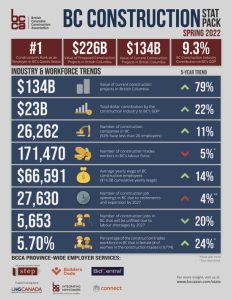
BCCA annual survey: Construction prices and activity remain high
April 18, 2022
By
Adam Freill
British Columbia’s construction industry is experiencing a 79 per cent increase in the value of current projects from five years ago, and a 17 per cent increase from pre-pandemic levels, even as labour shortages continue, and costs of goods are at all-time highs. Those details were amongst the findings of the annual B.C. Construction Association (BCCA) Industry Survey and highlight some of the key issues facing employers and workers during this period of heightened construction activity.
Despite an increase in project spending to $134 billion and a sustained increase in the number of construction companies in B.C., which now sits at 26,262, the number of employees in the industry has dropped across all trend milestones. Number of employees is down two per cent from last year, a nine per cent compared to pre-pandemic (2019) levels, and five per cent when compared against the five-year marker. Average company size has fallen over the past five years to an average of 6.53 workers, and nine out of 10 companies in the industry employ fewer than 20 workers.
As the labour pool shrinks, wages are rising. Construction salaries have seen a rise of 14 per cent since 2015, reaching an average of $66,591. This is an eight per cent increase since pre-pandemic levels alone. Nearly all workers are working full time, with 84 per cent being year-round, and half earning a higher wage than last year. Nearly 37 per cent of survey respondents report taking a new job for more pay this year, and 41 per cent have worked for two or more employers.
Workers are also getting more skilled. Roughly three out of four survey respondents report they are fully credentialed. Another 12 per cent working on their ticket. More women are receiving subsidized training and mentorship than men, and the number of companies with diversity policies in place has risen to 84 per cent from 62 per cent just a few years ago.
The construction industry’s contribution to the province’s GDP is up a whopping 22 per cent, growing from $18.8 billion in 2017 to $23 billion today. The sector remains the top employer in B.C.’s goods sector. More than 215,000 British Columbians rely directly on construction for a paycheque. This figure is down two per cent since 2017, but it is still larger than any other goods-producing sector in the province.
“Construction is an essential and highly dynamic industry that is affected by events next door and around the world” says Chris Atchison, BCCA president. “Whether its pandemic, floods, fires, war, supply chain, or government policy, our industry adapts to reflect those challenges.”
At least 17 per cent of the projected skills gap has been filled by tradeswomen, who now represent 5.7 per cent of the skilled workforce, and 5.5-times more likely to recommend the trades as a career path.
Covid-19, which appeared at number 3 in the survey’s list of issues of concern last year, has fallen downward on the stressors. Top issues for survey respondents this year were lack of prompt payment, workforce shortages, and eroding public sector procurement standards.
More information regarding the value of the construction industry to the B.C. economy can be found in the association’s Spring 2022 Stat Pack.

